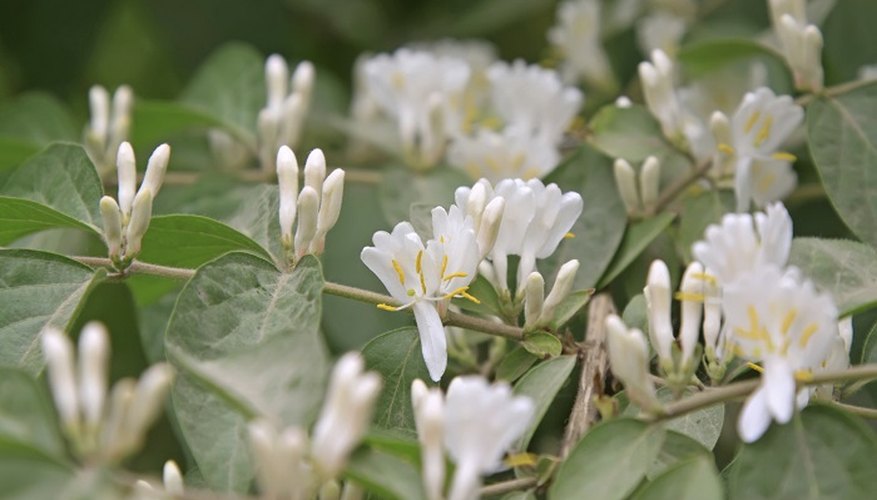Honeysuckle is a genus of a variety of ornamental shrubs and vines. Browning of shoots and leaves on honeysuckle is a common symptom of disease or insect infestation. Early identification of the pest or disease, prevention and control are vital for reducing the severity of these disorders.
Honeysuckle leaf blight
Honeysuckle leaf blight is a fungal disease that affects foliage, caused by Insolibasidium deformans. Symptoms of the disease first appear during the spring and favour cool temperatures, with high humidity for infection. Leaf blight symptoms consist of yellow to brown leaf discolouration, crinkled leaves, leaf curl and leaf drop. While the disease rarely causes serious damage to honeysuckle, it can overwinter on fallen infected leaves and cause yearly infection. Rake and destroy infected fallen leaves, prune infected foliage and stems and avoid free moisture on foliage to prevent infection. Chemical fungicidal spray is effective during the spring to prevent yearly infections.
- Honeysuckle leaf blight is a fungal disease that affects foliage, caused by Insolibasidium deformans.
- While the disease rarely causes serious damage to honeysuckle, it can overwinter on fallen infected leaves and cause yearly infection.
Leaffolding aphid
The honeysuckle leaffolding aphid is a small, soft-bodied insect that sucks nutrients from terminal shoots and leaves of honeysuckle. The leaffolding aphid feeds in colonies and can cause considerable damage to honeysuckle if left uncontrolled. Symptoms of aphids consist of leaf curl, stunted stem growth, leaf browning and stem death. Yearly leaffolding aphid infestations can lead to reduced plant vigour and death. The eggs of the leaffolding aphid overwinter on honeysuckle stems. Prune and burn infected stems and leaves to prevent overwintering. Chemical insecticides in the early spring growing season through summer are an effective method of control. Some honeysuckle varieties have a natural resistance to the leaffolding aphid and do not require treatment.
- The honeysuckle leaffolding aphid is a small, soft-bodied insect that sucks nutrients from terminal shoots and leaves of honeysuckle.
- The leaffolding aphid feeds in colonies and can cause considerable damage to honeysuckle if left uncontrolled.
Spider mites
Spider mites are a small pest of honeysuckle, closely related to spiders, that suck nutrients from stems and leaves. Like the leaffolding aphid, spider mites cause extensive shoot and foliage damage. Spider mites favour warm temperatures between 26C and 32C for infestation and population growth. Symptoms of infestation consist of white to brown streaking on leaves and visible spider mite movement on leaves and stems. In low populations, spider mites are hard to spot. However, visible movement on leaves is noticeable with high populations. Natural predators control mild to moderate infestations. However, insecticidal soap, horticultural oil and chemical insecticides are an effective method of control for severe infestations.
- Spider mites are a small pest of honeysuckle, closely related to spiders, that suck nutrients from stems and leaves.
- Symptoms of infestation consist of white to brown streaking on leaves and visible spider mite movement on leaves and stems.
Powdery mildew
Powdery mildew is a common plant and shrub fungal disease that affects numerous ornamentals, including honeysuckle. Symptoms of infection consist of power build-up on leaves and stems, leaf yellowing, leaf browning and shoot distortion. While powdery mildew is not a serious disease, it reduces plant vigour by preventing sunlight to give nutrients to leaves and shoots. The disease favours temperate weather conditions between 15C to 27C for infection and high humidity. Increase air circulation by pruning branches and increase plant vigour by regularly watering and fertilising to prevent a powdery mildew infection. Treat severe powdery mildew infections with chemical fungicides to reduce the damage from the disease.
- Powdery mildew is a common plant and shrub fungal disease that affects numerous ornamentals, including honeysuckle.
- While powdery mildew is not a serious disease, it reduces plant vigour by preventing sunlight to give nutrients to leaves and shoots.
